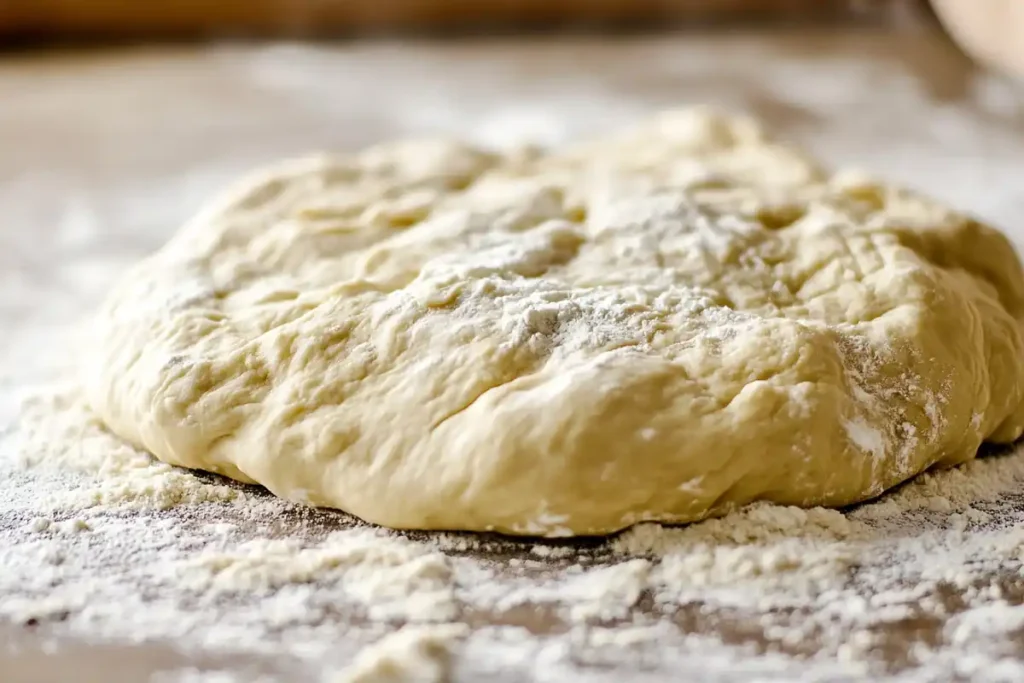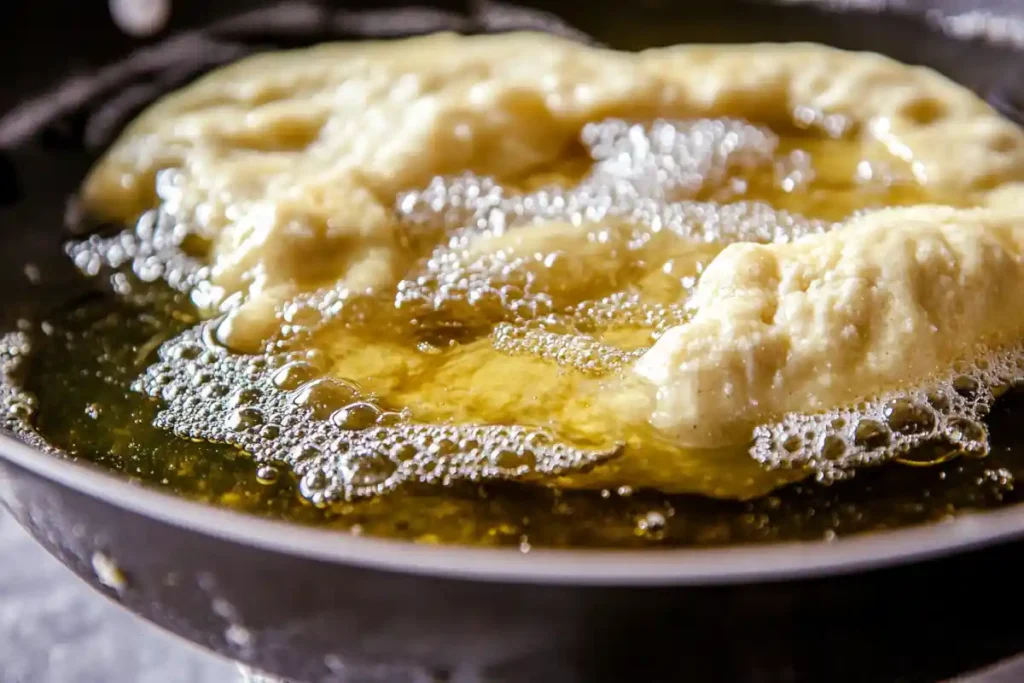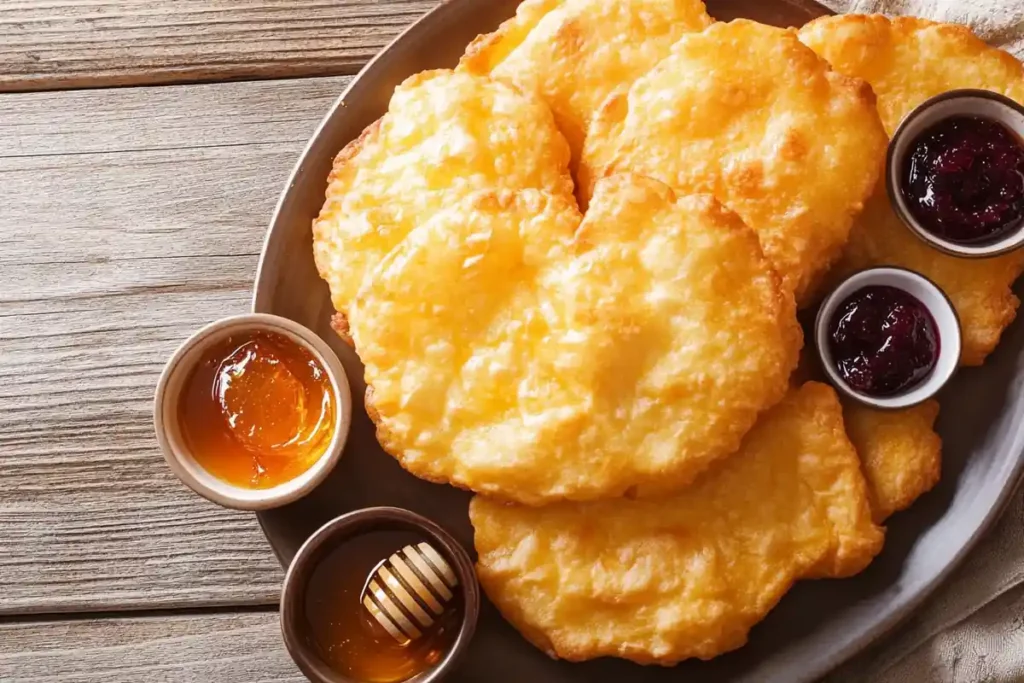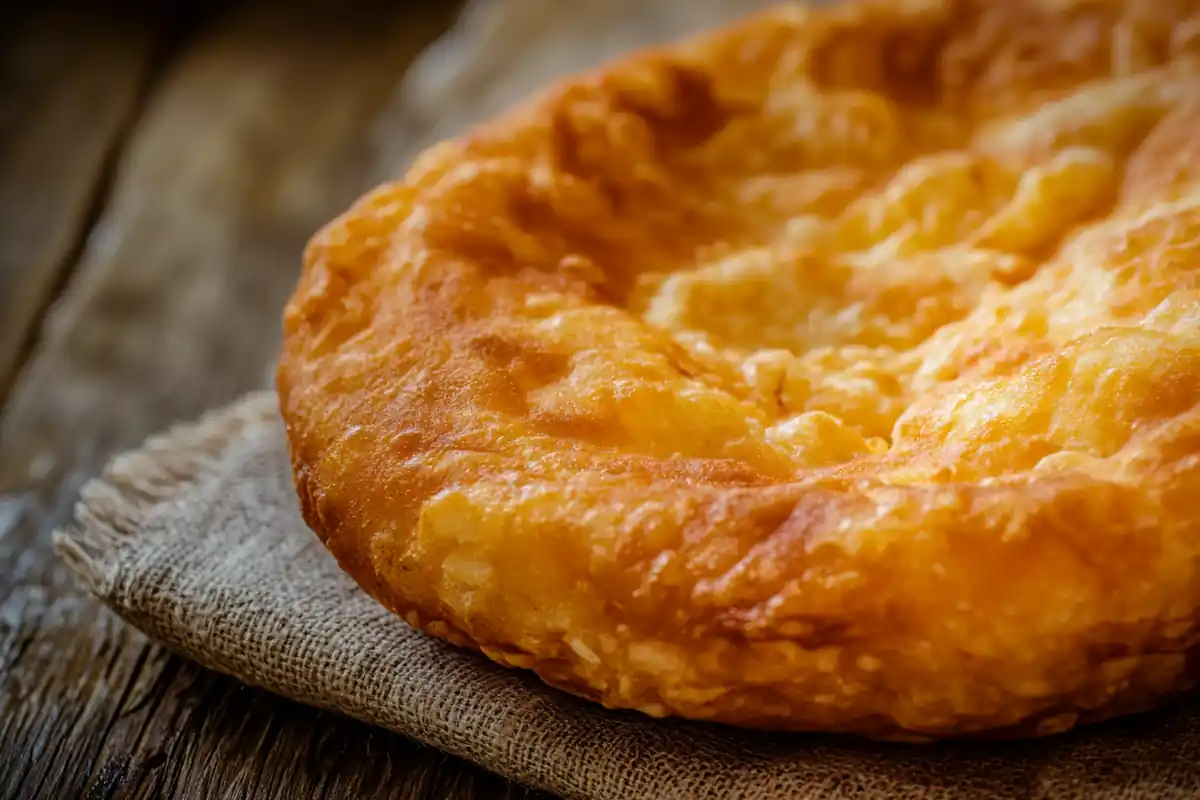Making yeast fry bread at home is a delightful way to connect with tradition while enjoying something incredibly tasty and versatile. This article walks you through a foolproof yeast fry bread recipe, its cultural background, essential ingredients, step-by-step cooking instructions, and helpful tips to make your fry bread turn out golden, airy, and absolutely irresistible. Whether you love it sweet with honey or savory as the base of a taco, we’ve got it all covered. Let’s get started!
Table of Contents
What Makes Yeast Fry Bread So Special?
Yeast fry bread stands out for its fluffy texture, crispy edges, and deep flavor. Unlike traditional frybread made with baking powder, the yeast version rises beautifully and adds a subtle tang that pairs with sweet or savory toppings.
It’s simple, versatile, and rooted in tradition making it perfect for family dinners, quick snacks, or even creative meals like Indian tacos.
This recipe is great for beginners and pros alike. It only takes a few pantry staples and a bit of love to create something warm, golden, and totally delicious. Whether you top it with honey or load it up with taco fixings, this bread never disappoints.
The Origins of Yeast Fry Bread
Yeast fry bread has roots in Native American history, born out of hardship during forced relocations when families made do with government-issued rations. Traditional fry bread used simple ingredients like flour and lard, but over time, some communities began adding yeast for a fluffier, more flavorful result.
Today, yeast-raised versions honor that tradition while offering a softer texture and richer taste making them a delicious evolution of a powerful cultural staple.s time than traditional loaf baking.
Essential Yeast Fry Bread Ingredients and Their Roles
Core Ingredients You’ll Need for Yeast Fry Bread
Before you start mixing and frying, let’s break down the basic ingredients that give yeast fry bread its signature texture and taste. These staples are likely already in your pantry:
- All-purpose flour: The structure-builder. It holds everything together.
- Active dry yeast: The magic that gives the dough its rise and pillowy softness.
- Warm water or milk: Activates the yeast and brings the dough together.
- Salt: Balances the flavor and strengthens the dough.
- Sugar: Feeds the yeast and adds a touch of sweetness.
- Oil (for frying): Helps create that golden, crispy finish.
Each ingredient plays a key role. Together, they create a dough that’s easy to work with and fries up beautifully light and fluffy.

Optional Ingredients to Elevate Flavor and Texture
While the core ingredients are enough to make a delicious batch, here are a few extras that can take your fry bread to the next level:
- Powdered milk: Adds richness and a slight creaminess to the dough.
- Butter or shortening: Enhances softness and flavor.
- Egg: Optional for extra richness and structure (great if you want a slightly cakier texture).
Experimenting with these additions can help you find your perfect version of homemade fry bread.
Ingredient Quality Matters
For best results:
- Use fresh yeast. Expired yeast won’t activate and your bread will fall flat.
- Choose unbleached flour for better gluten development and flavor.
- Use a neutral-flavored oil (like canola or vegetable) for frying.
Tools You Need for Yeast Fry Bread
You don’t need fancy gear just the basics:
- Mixing bowl & spoon for the dough
- Rolling pin (optional) to shape
- Heavy skillet or deep fryer for crisp results
- Thermometer to keep oil at the right temp
- Tongs or slotted spoon to flip and drain
Having these ready makes the frying process smooth and mess-free!aven.
Step-by-Step Yeast Fry Bread Recipe – From Dough to Delicious
Preparing the Perfect Yeast Dough
Making the dough is where the magic starts. This step sets the stage for soft, chewy insides and crispy outsides. Here’s how to bring it all together:
- Activate the yeast
- In a large bowl, mix 2¼ tsp active dry yeast with 1 tsp sugar and ¾ cup warm water or milk (about 105°F–110°F).
- Let it sit for 5–10 minutes until bubbly. This means the yeast is alive and ready to go!
- Add dry ingredients
- Stir in 2 cups of all-purpose flour and ½ tsp salt.
- Mix with a spoon or spatula until it starts forming a shaggy dough.
- Knead it out
- Dust a clean surface with flour and knead the dough for 5–7 minutes until smooth and elastic.
- If it’s sticky, add a bit of flour. If it’s dry, splash a little water.
- Let it rise
- Place the dough in a greased bowl, cover it with a towel, and let it rest in a warm spot for 1–1.5 hours, or until it doubles in size.

Shaping the Dough for Frying
Once your dough has risen and is nice and puffy, it’s time to shape it:
- Punch down the dough gently to release air.
- Divide it into 6–8 equal pieces.
- Flatten each ball into a ¼ inch thick disk using your hands or a rolling pin.
- Don’t stress about perfect circles rustic is part of the charm!
How to Fry Yeast Fry Bread Like a Pro
Here’s where it gets crispy and golden!

- Heat the oil
- In a heavy skillet, heat 1–2 inches of oil to 350°F–375°F.
- Use a thermometer for accuracy too cool and it’ll be greasy, too hot and it’ll burn.
- Fry the dough
- Carefully place one piece of dough into the hot oil.
- Fry for 1–2 minutes per side or until puffed and deep golden brown.
- Flip only once to avoid absorbing too much oil.
- Drain and cool
- Remove using tongs or a slotted spoon.
- Set on paper towels or a wire rack to drain.
Repeat with the remaining dough rounds and resist the urge to eat them all hot from the skillet (okay, maybe eat just one 😋).
Serving Hot and Fresh
Serve immediately while still warm for the best flavor and texture.

Tasty Yeast Fry Bread Variations
Yeast fry bread is incredibly versatile you can go sweet or savory with endless topping options.
Savory ideas include Indian tacos with meat, beans, and cheese, or breakfast versions with eggs and avocado.
Sweet styles shine with honey, cinnamon sugar, or jam for a cozy dessert vibe.
You can even add herbs, cheese, or vanilla to the dough for a custom twist. However you dress it up, this bread is always a hit!heavy to puff up while frying.
Expert Tips and Common Mistakes When Making Yeast Fry Bread
Pro Tips for the Fluffiest Yeast Fry Bread Ever
Even though yeast fry bread is beginner-friendly, a few insider tips can make a big difference in your final results. Here’s how to take your bread from good to unforgettable:
- Proof your yeast: Always activate your yeast in warm (not hot!) liquid. Temps between 105°F–110°F are just right.
- Let the dough rise fully: Don’t rush it. A full rise means light, airy texture and better flavor.
- Keep your oil at a steady temp: Use a thermometer to maintain 350°F–375°F. Too cool, and the bread absorbs oil; too hot, and it burns.
- Fry in small batches: This keeps the oil from dropping in temperature, so each piece cooks evenly.
- Serve immediately: Fry bread is best hot and fresh. Reheating works, but nothing beats that first crisp bite.
Common Mistakes to Avoid with Yeast Fry Bread
Don’t worry we’ve all been there. Avoid these slip-ups to keep your fry bread from falling flat (literally):
- Skipping the rise: No rise = dense bread. Patience is key.
- Over-kneading the dough: This can make it tough. Once it’s smooth and stretchy, you’re done.
- Using too much flour: Especially during kneading. It’ll dry out your dough fast.
- Crowding the pan: More dough = lower oil temp = soggy, sad bread.
- Flipping too often: One flip is plenty. Overhandling interrupts puffing and can cause uneven frying.
Signs Your Fry Bread Is Perfect
Keep an eye (and nose) out for these signs of success:
- Puffy and golden brown with gentle blistering
- Light and chewy texture inside, with crisp edges
- Slightly yeasty aroma (not sour or overly bready)
- Doesn’t feel greasy or heavy
When you get these results, you’ll know you’ve nailed the perfect yeast fry bread recipe!
Yeast Fry Bread Nutrition Facts – What You Should Know
What’s in a Serving of Yeast Fry Bread?
Let’s be real yeast fry bread isn’t exactly diet food, but that doesn’t mean you can’t enjoy it as part of a balanced lifestyle. One medium-sized piece (about 6 inches in diameter) usually contains:
- Calories: ~200–300
- Total Fat: 8–15g (depends on how much oil is absorbed during frying)
- Carbohydrates: 30–40g
- Protein: 4–6g
- Fiber: ~1g
- Sodium: ~200–300mg (depending on your salt use)
Note: These values can vary depending on the ingredients and portion size.
How to Enjoy Fry Bread More Mindfully
If you’re looking to enjoy your fried yeast bread without overdoing it, here are a few helpful tips:
- Portion control: Try making smaller rounds for lighter servings.
- Use quality oil: High-smoke-point oils like avocado or canola are healthier and fry cleaner.
- Drain well: Always let fry bread rest on paper towels or a wire rack to remove excess oil.
- Balance the meal: Pair your bread with veggies, lean proteins, or fiber-rich sides to create a more complete dish.
Enjoying this bread occasionally, with awareness, is all part of savoring life’s little indulgences.
Lighter Alternatives and Substitutions
Want to cut back a bit but still enjoy that fry bread vibe? Try these swaps:
- Use whole wheat flour for extra fiber.
- Fry in less oil, or use an air fryer for a lighter version (yes, it works!).
- Swap milk for unsweetened almond milk if you’re dairy-free.
Little changes can make a big impact while keeping the flavor intact.
Frequently Asked Qs About Yeast Fry Bread
Can I make yeast fry bread dough ahead of time?
Absolutely! Prepare the dough and let it rise once. Then:
- Punch it down.
- Cover and refrigerate it for up to 24 hours.
- Let it come back to room temperature before shaping and frying.
This is perfect if you want to prep ahead for a gathering or save time on busy nights.
Why didn’t my dough rise?
A few common reasons:
- Old or expired yeast: Always check the date.
- Water too hot: Kills the yeast. Keep it around 105°F–110°F.
- Room too cold: Yeast needs a warm, cozy environment to activate.
- Skipped sugar: Yeast feeds on sugar during activation. No sugar = no bubbles.
If your dough isn’t puffing up, start over with fresh yeast and warm liquid you’ve got this!
What oil is best for frying yeast-raised frybread?
Choose a neutral oil with a high smoke point like:
- Canola oil
- Vegetable oil
- Avocado oil (great for a slightly healthier option)
Avoid strong-flavored oils like olive or sesame they’ll overpower the subtle, toasty flavor of the yeast fry bread itself.
Conclusion
Yeast fry bread is more than just a recipe it’s a flavorful blend of history, comfort, and creativity. Whether you enjoy it sweet, savory, or somewhere in between, this versatile bread is a must-try for any home cook. With the right ingredients, simple tools, and a little love, you’ll be frying up golden, fluffy perfection in no time. Happy cooking!

